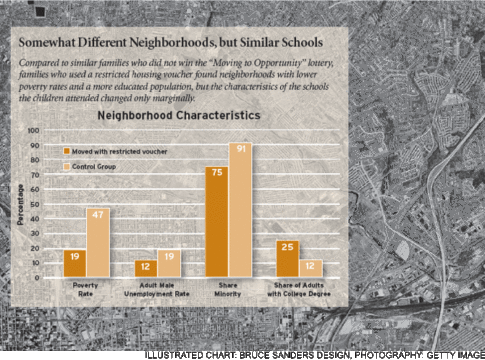
State and federal school accountability programs hold schools to specific standards of academic performance and assume each school is given a fair shake at accomplishing the task of educating its students. But are schools, in fact, treated fairly, at least with respect to funding? Over the past 35 years, reforms adopted in most states have dramatically improved the equity of funding from one school district to another.
But in recent years a new concern has surfaced: What if it’s not the district but rather the specific school a child attends within a district that matters most for accessing educational resources? Mounting evidence suggests that districts commonly distribute different amounts of funding, even when schools serve the same types of students. Our research and that of others indicate that schools with predominantly junior teachers receive fewer salary dollars than do schools staffed with veterans. Further, districts often compound these inequities by distributing a smaller share of unrestricted funds to the same schools that are shortchanged in salary dollars.What we don’t yet know about school funding inequalities is whether and how these discrepancies have changed in recent years. Nor is there much information available about how spending differences within districts compare to differences between districts in the same state.
In this study, we address these questions by taking an in-depth look at funding differences between and within Texas school districts over the course of a decade, from the 1993–94 to 2002–03 school years. Within Texas, we focus our attention on large school districts, those with more than 25,000 students. In 1994, the state had 29 districts with an enrollment greater than 25,000, and that number increased to 39 by 2003. These districts serve about half of all Texas public school students.
Texas’s large districts are useful cases for two reasons. First, other studies of school funding equity have suggested that funding discrepancies are greatest in the largest and most urban school districts. By focusing on large districts, we are more confident that we are identifying the full extent of inequality that exists between schools. At the same time, we recognize that we may not be able to generalize our findings beyond such districts.
Second, the state of Texas has in recent years aggressively addressed funding inequalities between districts. In 1993, following a state supreme court order to equalize public school spending, the state’s school finance system adopted a provision known as the “Robin Hood” law that requires property-rich districts to subsidize poorer districts within the state. Studying Texas districts and schools allows us to assess whether and how policies designed to reduce inequities between districts affected inequalities between schools within districts.
Our findings demonstrate that, at least in Texas, funding decisions within districts currently have a greater impact on a school’s resources than inequalities in access to revenues across school districts. Although reforms have been successful in reducing inequalities between Texas districts, variation in funding within districts remains high. As a result, examining only data aggregated to the district level, still the standard practice in equity studies, misses much of the inequality in funding across schools.
Data and Methodology
We obtained financial and descriptive information about Texas districts with more than 25,000 students and the schools within those districts from a large database published by the Texas Education Agency. The database reports financial allocations to schools by district. For each school, we know the nontargeted, or noncategorical, allocations made for each student who attends the school as well as how much the school received for five targeted groups of students: students eligible for free or reduced-price lunch, students eligible for bilingual education programs, students with disabilities, gifted students, and students in vocational education programs. We exclude charter schools from our analysis, as their funding levels are not determined by the same policies that affect traditional public schools.
We first examine the differences between schools in noncategorical resources by comparing each school’s per-pupil funding to the average per-pupil funding in the district. We make this comparison by calculating the ratio of each school’s per-pupil noncategorical expenditure to the district’s average per-pupil noncategorical expenditure. For example, if School A receives $4,000 per pupil in noncategorical funds but the district average per pupil is $5,000, then the ratio for School A is 0.8 (or 80 percent of the district average). Since the ratio compares individual school funding to the average for the district, we know that any funding differences we see are entirely the product of intradistrict rather than interdistrict variation.
Next, we compare total spending, including funds allocated specifically for students eligible for free or reduced-price lunch and bilingual, vocational, or gifted education. We exclude special education funds from this analysis because of large variations in funding depending on disability type.
For each district, we compute the district’s average expenditure for each student-need group. For example, one district may allocate an average of $500 on top of the nontargeted allocations for each gifted student, while another district might allocate only an average of $200. This average is effectively an implicit spending weight unique to each district, determined by dividing the sum of all allocations made on behalf of each student type by the number of students in that category.
We then calculate a ratio, called a Weighted Student Index (WSI), of the actual funding received by each school to the funding we would expect if schools received the district’s average allocation for its particular mix of students. The WSI allows us to compare per-pupil funding in schools while accounting for the types of students a school serves. A school with a WSI of 0.7 receives 70 percent of what we predict the school would be allocated, given its student population, if all the schools in the district received the same amount for each student of each type enrolled in the school.
We follow standard practice among school finance researchers who are interested in studying potential inequality at both ends of the spectrum, and calculate for each school year in our study the coefficient of variation for the differences in funding within districts. We define the coefficient of variation as the standard deviation of the population divided by its mean. Since the mean value of our two spending indexes is 1.0, the coefficient of variation is actually equivalent to the standard deviation in our analysis. The value of 0 indicates perfect equity, with larger values signaling greater disparities in the allocation of funds. Researchers studying spending differences between districts have established 0.1 as an acceptable level of equity, and we follow this convention in our analysis of between-school spending differences.
As an additional point of comparison, we also examine spending inequalities between districts. In this analysis, we adjust spending figures to reflect differences in district size and in the costs of providing education before calculating the coefficient of variation. For both the between-schools and between-districts analyses, the dollars analyzed include total operating funds from federal, state, and local governments, and use real-dollar teacher salaries.
The Funding Picture
Throughout the decade we study, the 1993–94 to 2002–03 school years, noncategorical funding between schools within Texas districts was considerably less equal than between districts. The coefficient of variation calculated in the between-school analysis was consistently higher than that calculated in the between-district analysis. We removed the state’s four largest urban districts from the sample and found between-school inequities were still much higher than inequities between districts.
There has been modest progress toward equity of noncategorical funds across districts and schools in Texas over the last decade (see Figure 1a). At the district level, the coefficient of variation in 1994 was 0.09, dropping to 0.07 in 2003. The coefficient of variation among schools for the 1993–94 school year was 0.17, dropping to 0.14 by the 2002–03 school year. The good news is that in 2003, the coefficient of variation across schools in 24 of Texas’s 39 largest school districts was less than 0.1. The average coefficient of variation across schools, however, exceeded this benchmark in each year.

When we examined noncategorical per-pupil funding in the state’s four largest school districts—Austin, Dallas, Fort Worth, and Houston—the levels of inequity were even higher and each district was remarkably different from the others. In Dallas, Fort Worth, and Houston, the coefficients of variation were nearly always more than 0.15, meaning that one-third of the schools in these districts had spending levels that deviated from their district’s average by 15 percent (or $225,000 for a school of 500 when average spending is $3,000 per pupil). In contrast, Austin had a coefficient of variation near 0.15 for most of the decade, but dipped to the 0.1 level for three years, from 1997–98 to 1999–2000. Houston ranged between 0.2 and 0.25, except for one year, while Dallas had the highest levels of inequality, hovering around 0.3 until the 2000–01 school year, when it experienced a dramatic drop in the level of inequality in the district, indicating that a greater percentage of schools were funded at or near the district’s average allocation per pupil.
During the decade we studied, Fort Worth made steady improvements toward equity in noncategorical funding across its schools, while Austin’s allocations became less evenly distributed over the last five years in our study. And while there appear to be some equity gains in these four districts over the last two years of this analysis, there is no clear long-term trend toward improvement.
Figure 1b shows the equity picture for total funding over the period. While inequities both between and within districts have decreased over the past 10 years, there is still greater variation across schools than across districts. Taking into account resources expended for particular student types, then, does not change the patterns in noncategorical spending described above in any meaningful way.
The Impact of School Characteristics
Of course, we should not assume that all inequalities in spending between schools are necessarily perverse. District officials in Texas might point out that there are reasons aside from special student needs that could legitimately prompt uneven funding among schools. School level, school size, and academic performance are often cited as factors that shape strategic funding allocations to schools. Districts might, for example, allocate a relatively larger share of resources to high schools because they are expected to provide a diverse curriculum. Similarly, a district could be spending more on its lowest-performing schools to support improvement efforts. As discussed above, though, previous research documents spending differences resulting from less intentional factors, primarily differences in teacher salary costs due to different levels of teacher experience.
In order to investigate the role of both the intentional and unintentional factors, we explore the extent to which various school characteristics explain variation in the allocation of resources within a school district. We look at level of school (high school, middle school, or elementary school), total enrollment, percentage of the student body that is white, average experience of teachers, and school performance, as measured by the school’s academic rank within the state. Using data from the 2001–02 school year for our sample of large Texas districts, we estimate the amount of variation in total per-pupil funding, measured by a school’s WSI, that we can attribute to such school organizational characteristics.
We find that, as expected, high schools tend to receive more funding. On average, a high school’s WSI is 0.18 higher than an elementary or middle school, indicating that high schools received 18 percent more than elementary or middle schools within the same district with similar student populations. There is some indication that the lowest-performing schools in a district have higher WSI scores, and additional analyses reveal that this pattern is concentrated among elementary schools. Unexpectedly, we do not find a clear or strong relationship between school size and WSI values. Nor do we find that schools with a larger share of white students have a meaningful increase in their WSI.
Schools with more experienced teachers and the lowest–performing schools receive slightly more funding from the district, with higher WSI by 0.01 and 0.04, respectively. In other words, these schools typically received 1 to 4 percent more than the district average, or $15,000 to $60,000 per school of 500 students in a district where the average school expenditure is $3,000 per pupil.
These findings aside, it turns out that relatively little of the differences in funding by schools is explained by these school and district characteristics. We can account for only slightly more than one-third of all the variation between schools in the same district. If spending is not strongly influenced by observable school characteristics, we have to question whether it is driven by a district strategy at all. What we haven’ within and outside the district, organizational habits, and de facto policies at play in the system that can and likely do affect how districts distribute resources among schools.
Weighted Student Formulas
There have been calls for district policies that would transparently and equitably allocate district resources among schools, with the use of an explicit formula. Districts that adopt a weighted student formula (WSF) for funding schools allocate funds according to the specific student types enrolled. Spending increments, or weights, are deliberately determined for each student need. Were the districts in this analysis to allocate funds using a strict WSF system, we would not have found any inequities between schools. Each school would receive exactly the average allocation for its mix of students, and the coefficient of variation for each district would be 0.
To date, only a handful of districts have implemented WSF, and certainly not in the strict sense described here. In 1998, Houston implemented a modified version of WSF, known as student-based budgeting, in which a base amount is set per student and a percentage added for each special need, such as bilingual education. While we would not feel comfortable claiming, based on the analysis here, that student-based budgeting has been the cause of greater equity in Houston’s school funding system, our findings do show that despite an initial increase in the coefficient of variation, Houston schools have over the longer term made modest improvements in equity since the strategy was put into place.
There are reasonable concerns about the consequences of WSF funding. First, district leaders may not select appropriate weights. They may choose, for instance, to allocate too little for each student in bilingual education or too much for each student in gifted programs. Second, some inequality is likely to remain even with a WSF system. WSF models typically ignore the effect of differences in teacher experience levels and, therefore, teacher salary across schools by adjusting the allocations for real salaries after the weighted formula has been applied.
Regardless of whether WSF systems are the answer, there is a clear and simple policy lesson in the experience of large Texas school districts. We should not assume that school finance reforms directed at resolving resource inequalities between school districts will ensure those resources are equitably distributed among schools and their students.
Marguerite Roza is research assistant professor, Kacey Guin is research associate, Betheny Gross is senior research associate, and Scott DeBurgomaster is research assistant at the Center for Reinventing Public Education at the Evans School of Public Affairs at the University of Washington.





